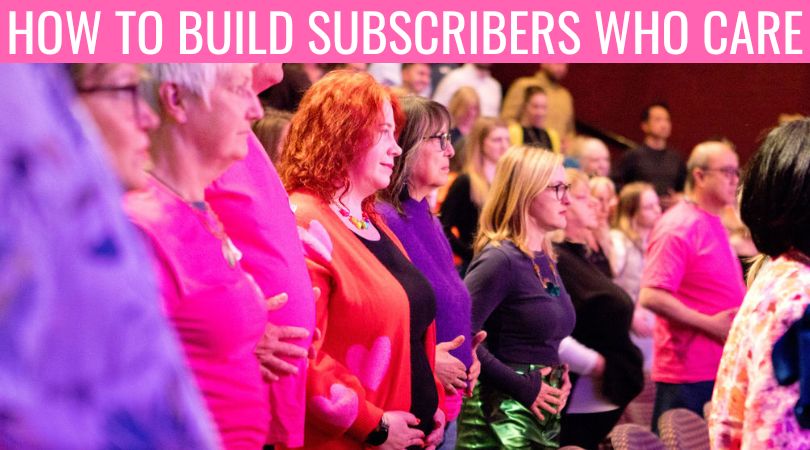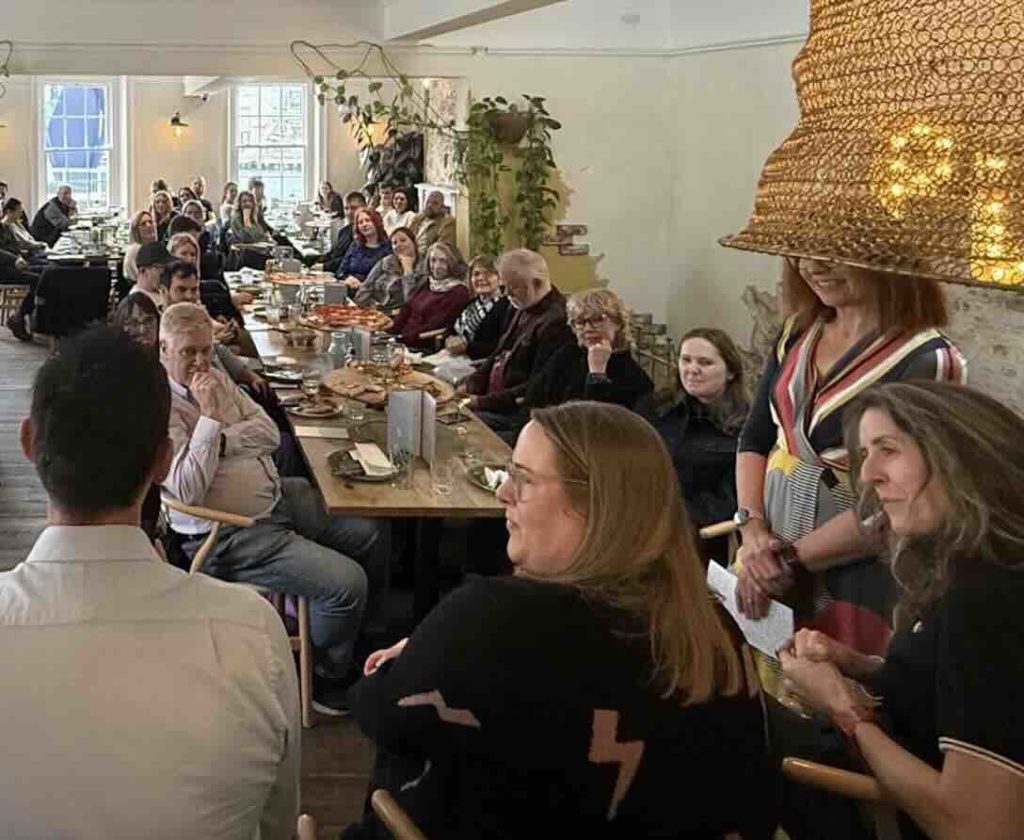Let’s learn and create together!
Book your placeDitch Vanity Metrics: How To Build Subscribers Who Care

Encouraging people to subscribe to you means you’re increasing your chances of building better relationships.
When someone provides their email, it feels like asking them to make a commitment where inboxes are crowded and we’re told attention spans are getting shorter. Then again, it’s an opportunity to make someone’s day better, inspire an idea, or spark a connection
It’s not easy, but it is possible and it can be one of the most rewarding initiatives you ever pursue.
What follows isn’t just a roadmap; it’s an approach to showing up, being consistent, and creating something that people genuinely want to be part of. Let’s dive in.
You don’t need to become fixated on big numbers. You don’t need to have 1,000 fans. What you really need is a solid foundation from which to grow and a group of people who genuinely care about what you have to say.
It is empowering to know there are people on your side when it’s all going great, but also when you you face challenges.
Why Subscribers Are Worth the Effort
An email subscriber isn’t just a number or someone you don’t know—it’s a real person who’s chosen to hear from you.
This person has made that commitment to you and it’s now your responsibility to not let them down. Your goal is to demonstrate to them that you are the right person to support them.
Unlike social media, where algorithms deter what people see, email gives you a direct line of communication. Ok, the walls of Gmail and Hotmail are getting higher and stricter, but this is your way to head directly to the person you want to reach. You start the relationship. You’re not renting space on someone else’s platform. This makes email subscribers the most valuable part of your audience-building efforts.
Take YATM (You Are The Media) as an example. When I started sending the weekly newsletter in 2013, I had no audience, no brand, and hardly anyone outside of my town knew who I was. Week after week, I showed up. Now, every Thursday at 6 a.m. GMT, I press send, knowing there’s a community of people who are there. That didn’t happen overnight, and it certainly didn’t come easy. It serves as proof that email works when you stick with it.
Starting at Zero: It’s Not as Bad as You Think
Everyone starts somewhere.
If you’re making those first steps, let me say: it’s ok to start small. What matters is that you begin. When I started YATM, the first email was sent to a mix of clients, prospects, and friends.
It took almost a year before someone I didn’t know subscribed—and that was someone in Australia.
Looking back, I’ve realised why those early days were such a struggle:
– Nobody knew who I was.
I was just a person in Poole sending emails, trying to get noticed. I didn’t have much of a presence, and I wasn’t giving people a reason to care.
– I wasn’t promoting the newsletter.
There was no sign-up box on my website, no mention on social media, nothing to make it easy for people to subscribe. I wasn’t working outside of the creation process.
– It felt transactional.
My emails were all about me—what I wanted, what I thought people should know. They weren’t engaging or enjoyable to read. At the start, I create a distance. I was telling people who didn’t know me, what to do.
– I didn’t say anything different.
There was nothing that made my newsletter stand out. There wasn’t an idea that people could associate with, feel connected to and get behind.
However, this isn’t just me, this represents thousands of other people who start and sadly give up. Slogging away for no return (subscribers) can become a lonely venture.
Maybe the above sounds familiar to you? If so, you’re not alone.
The Mistakes That Keep You Stuck
If you’re putting in the effort but not gaining subscribers, it’s helpful to take a step back.
The issue may not be the content you’re producing but rather how you’re presenting yourself.
– You’re too focused on what’s in it for you. If your emails feel like an ongoing sales pitch, people won’t bother signing up. Your job is to provide value, not push your own agenda. Someone else’s interest in you is invariably less than yours.
– You’re trying to compete with bigger players. Those who have been at the wheel for years and built sizeable audiences probably have teams, budgets, presence, domain dominance and years’ of experience. You can’t outdo them, but you can offer something they can’t, your voice and perspective that tie into what you stand for.
– It feels like a chore. If you’re not enjoying the creation and discovery process, your audience will pick up on it. Enthusiasm is contagious; lack of it is, too.
– Your sign-up process is invisible or uninspiring. “Subscribe to our newsletter” isn’t compelling. What’s in it for them? Why should they bother? When is it sent? Just because people can fill in an email form, doesn’t mean they will.
Building Momentum: What Actually Works
One of the biggest mistakes I made was assuming that simply producing an email newsletter would lead to subscribers.
When people are not familiar with you, you have to find a way to encourage people to subscribe.
Here’s what I’ve found to be most effective, especially when you can invest time instead of money:
1. Make it Easy for People to Subscribe
Your sign-up form shouldn’t be hidden at the bottom of your homepage. Make it visible throughout your site such as your footer on every page. Consider a dedicated landing page that tells people exactly what they’re signing up for and why it’s worth their time.
2. Show Proof of Value
Why should someone trust you with their email? Show them what they’ll gain. Share examples of past newsletters or testimonials from current subscribers. Be specific about the value you’re offering: insights, entertainment, connection or solutions. Being specific matters; the more detailed you are, the better you’ll connect with your audience.
3. Promote Like You Mean It
Don’t be shy. Share your newsletter on social media. The day before you publish share on socials what you are going to cover in the next issue. Many people tend to promote only after the newsletter is sent out. When you make new connections, share with them the main themes of your newsletter and the link to leave their email and why they might find it helpful.
4. Invite Your Audience to Share
Your existing subscribers can be your best promoters. Include a clear call-to-action in your emails asking them to forward the newsletter to someone who might enjoy it. Add a shareable link to your sign-up page, too.
5. Routine Encourages Persistence
Consistency builds trust. Choose a schedule and stick to it. If you write better in the morning or in the evening, make that your routine. If you’re publishing weekly, don’t miss a week. People need to know they can rely on you. It’s an unwritten etiquette to show up as promised when someone subscribes.
Creating a Newsletter That People Want
When someone subscribes, they’re trusting you with their time. Respect that by delivering something worth reading. Here’s how:
– Be Personal: Take the stance of speaking to one person, not an anonymous audience. Use your voice. It may take time, but shaping the real you can be your biggest asset. The best newsletters work because they are reflective of the person behind them
– Deliver Value: Every email should leave the reader feeling like they gained something, whether it’s knowledge, inspiration, or just a moment to kick back (every Thursday in the YATM newsletter is a section to waste time).
– Engage Your Readers: Encourage replies. Ask questions. Make it a two-way conversation, where people know that you will be there.
– Experiment and Improve: Pay attention to what resonates. Every week come back to your analytics to see what gets opened and clicked. Adjust accordingly. If you have sections that don’t attract much attention, you can tweak or delete.
Subscriber Goals as Part of Your Strategy
Don’t look at your newsletter as just a side project; it’s an integral part of your business. As your audience grows, so does your influence. Use your newsletter to:
– Test new ideas and hone your writing skills
– Build deeper connections with people
– Drive traffic to places where people can get to meet other subscribers, such as events
The key is to see your subscribers not just as potential customers but as valuable people who can be a part of your community. Serve them well, and they’ll stick around.
Let’s Round-Up
Building an email list isn’t about chasing numbers—it’s about creating meaningful connections, one person at a time. It’s a process of showing up, learning, and refining how you communicate your value.
The early days might feel like shouting into the void, but those quiet moments can be where creativity is born. When you keep going, you keep your audience’s needs at the heart of what you do and you’ll find that your efforts pay off in ways that go beyond subscriber counts.
Start with the people who already believe in you. Create something they genuinely look forward to. Share your voice, your insights, and your ideas, and invite others to be part of what you’re building.
Over the years I have realised that every email is an opportunity to resonate deeper, build trust and connection in ways that go far beyond the inbox. That’s the real power of a newsletter—and it’s well worth the effort.

Build Your Community
A brand new programme from Mark Masters for businesses wanting to make that next growth step.
Find out moreYATM Club
Where non-conformist business owners come to work, learn and make friends. Click here

